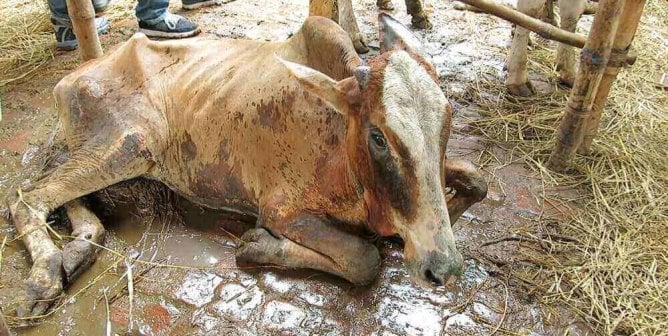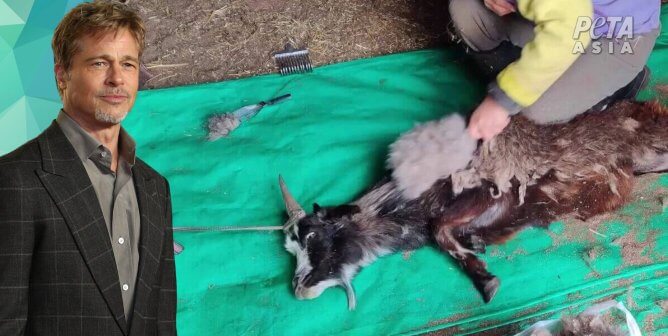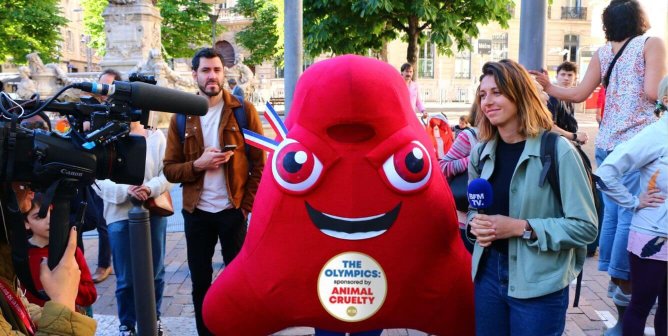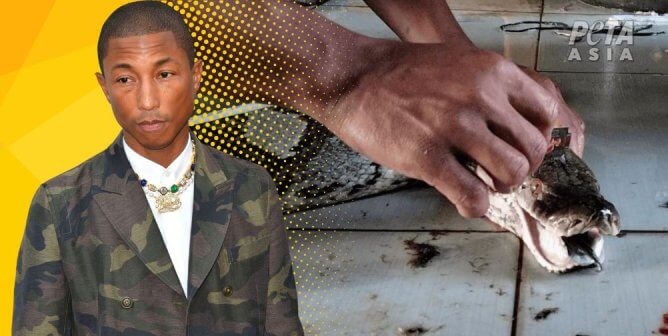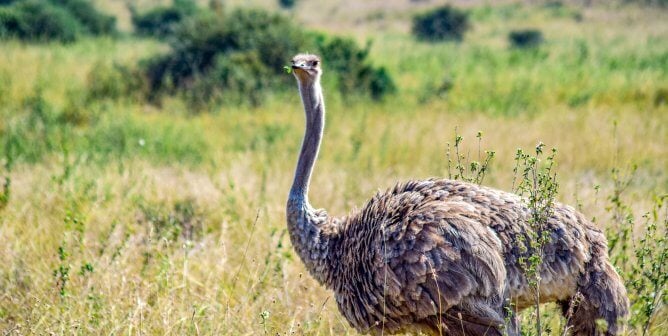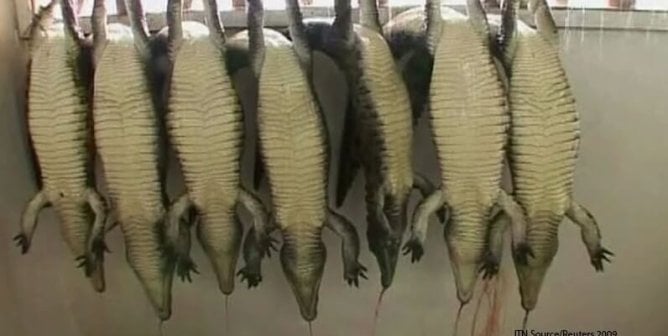Inside the Wool Industry
Without human interference, sheep grow just enough wool to protect themselves from temperature extremes. The fleece provides effective insulation against both cold and heat. Wool was once obtained by plucking it from sheep during their molting seasons. Breeding for continuous fleece growth began after the invention of shears.1
Shearing Plus Mulesing Equals Sheep Abuse
With approximately 68 million sheep, Australia produces 25 percent of the world’s wool.2,3 Flocks usually consist of thousands of sheep, making it impossible to give attention to an individual sheep’s needs. For instance, it is considered normal in the Australian wool industry for at least 4 percent of young lambs to die every spring from poor nutrition.4 Because there is so much death and disease in the wool industry, the rational solution is to reduce the number of sheep who are used for their wool in order to maintain them properly. Instead, sheep are bred to bear more lambs in order to offset the deaths.
In Australia, the most commonly raised sheep are merinos, who are specifically bred to have wrinkled skin, which means more wool per animal. This unnatural overload of wool causes animals to die of heat exhaustion during hot months, and the wrinkles also collect urine and moisture. Attracted to the moisture, flies lay eggs in the folds of skin, and the hatched maggots can eat the sheep alive. In order to prevent this condition, called “flystrike,” Australian ranchers perform a barbaric operation called “mulesing,” in which workers carve huge strips of skin and flesh off the backs of lambs’ legs and the areas around their tails. This is done to produce smooth, scarred skin that won’t harbor fly eggs, yet the bloody wounds often get flystrike before they heal. Studies have shown that the procedure causes stress levels similar to those of castration and shearing, and the effects—pain, discomfort, and weight loss—can last for two to 14 days.5 One farmer (who successfully protects his sheep from flystrike by using a combination of fly traps, chemical sprays, breed selection, and grazing management) attributes the industry’s resistance to giving up mulesing to “a bit of old-boys’-club arrogance in a once-grand industry that is now struggling a bit.”6 When PETA first exposed this gruesome procedure, it prompted international outrage. Mulesing was banned in New Zealand, and Australian wool industry officials promised to phase it out by 2010, but more than a decade later they continue to bicker internally and most lambs in Australia are still being subjected to this horrific mutilation.
Sheep are sheared each spring, after lambing, just before some breeds would naturally shed their winter coats. Timing is considered critical: Shearing too late means wool loss. In the rush, many sheep die from exposure after premature shearing.
Shearers are usually paid by volume, not by the hour, which encourages fast work without regard for the sheep’s welfare. Experienced shearers clip more than 350 sheep in one day, and that pace is maintained for weeks at a time.7
PETA and its international affiliates have exposed cruelty to sheep on 117 different properties in six countries on four continents. Please visit PETA.org for details from an investigation of several shearing sheds in both Australia and the United States, where workers were seen violently punching sheep in the face, stamping and standing on the animals’ heads and necks and beating and jabbing them in the face with electric clippers and a hammer. Some sheep died from the abuse. Investigators also documented that large, bloody wounds were left on the sheep’s bodies and that workers stitched gaping wounds closed using a needle and thread without administering any pain relief.
In PETA’s latest investigation, an investigator documented conditions in Victoria, Australia—once again revealing that cruel practices are common in the wool industry. Shearers kicked sheep in the abdomen and back, punched them in the face, and even stood on one sheep’s neck as she flailed in fear. Workers talked about other shearers who had broken a lamb’s leg, cut up sheep, and gouged them in the eyes. A shearer still employed by the crew allegedly bit a sheep’s ear off in anger.
PETA also exposed conditions on a farms in Argentina that supplied wool to Patagonia. A witness found workers hacking into fully conscious lambs, starting to skin some of them while they were still alive and kicking, and otherwise mutilating, abusing, and neglecting lambs and sheep on farms in the Ovis 21 network. Patagonia announced that it was dropping Ovis 21 as a supplier and would not buy wool again until the company could be assured of “the humane treatment of animals.”
Live Export
Old or unneeded sheep are sold for slaughter. Millions of live sheep are shipped to the Middle East and North Africa every year. In 2006, in conjunction with Animals Australia, PETA conducted an undercover investigation to expose the handling and slaughter conditions endured by sheep who are exported to these destinations from Australia.
Despite the Australian government’s and the live-export industry’s claims that animals are treated humanely, the investigators found that sheep and cows were dragged off trucks by their ears and legs and left to die in barren feedlots. They were bound and thrown into the trunks of cars and then slaughtered in prolonged and cruel ways that are illegal in the U.S., Europe, and Australia.
Other Kinds of Wool
It may be called wool, mohair, pashmina, shahtoosh, or cashmere. But no matter what it’s called, any kind of wool means suffering for animals.
A first-of-its-kind PETA US undercover investigation of Mallkini – the world’s largest privately owned alpaca farm in Peru – revealed that workers held struggling, crying alpacas by the ears as they were roughly shorn with electric clippers, causing some to vomit out of fear. They slammed the alpacas – some of whom were pregnant – onto tables, tied them to a medieval-looking restraining device, and pulled hard, nearly wrenching their legs out of their sockets. The quick, rough shearing left the animals cut up and bleeding from deep wounds, which were sewn up without adequate pain relief. Mallkini is owned by the Michell Group, the world’s largest exporter of alpaca-wool tops and yarn. For more about this investigation, visit PETA.org.
Contrary to what many consumers think, “shearling” is not sheared wool. A shearling is a yearling sheep who has been shorn once. A shearling garment is made from the skin and coat of a sheep or a lamb who was shorn shortly before slaughter; the skin is tanned with the wool still on it.
Cashmere is made from the coats of cashmere goats, who are kept by the millions in China and Mongolia, which dominate the market for this “luxury” material.8,9 A PETA Asia video investigation conducted on cashmere farms and in abattoirs in China and Mongolia showed workers holding down frightened goats, who cried out in pain as their legs were bent and their hair was torn out with sharp metal combs. Goats left bloody from the hair-removal process received no pain relief or veterinary care – one worker simply poured rice wine directly into an animal’s wound. In China, goats deemed no longer profitable were slaughtered after workers hit them in the head with a hammer in an attempt to stun them. And in Mongolia, workers dragged them by one leg onto the abattoir floor before slitting their throats in full view of other goats. Some were seen still moving for minutes afterwards. For more on this investigation, visit PETA.org.
Merino or cashmere is combined with possum fur to create “perino.”10 The possums are hunted for their coats. Please see PETA’s factsheet on Trapping for more information on this vicious side of the wool industry.
Angora rabbits may be strapped to a board for shearing and kick powerfully in protest as clippers or scissors inevitably bite into their flesh. Angora rabbits have very delicate foot pads, so they often develop excruciatingly painful foot ulcers when they are forced to spend their lives standing on the floors of wire cages. Female rabbits produce more wool than do males, so on larger farms, male rabbits who are not destined to be breeders are killed at birth.11 At angora farms in China, a PETA Asia investigator found workers violently ripping the fur out of rabbits’ skin as the animals screamed in pain, a process they endured every three months for two to five years. For more information about the angora wool industry, please visit PETA.org.
Shahtoosh is made from the coat of the endangered chiru, or Tibetan antelope. Because chirus cannot be domesticated, they must be killed before their wool can be obtained. Although it has been illegal to sell or possess shahtoosh products since 1976, thousands of chirus are killed every year for shawls that are sold on the black market.12
A PETA Asia investigation of goat farms in South Africa showed workers roughly handling, mutilating, and even cutting the throats of fully conscious goats in South Africa, which supplies more than half the world’s mohair.13 Subsequently, some of the world’s largest clothing chains, including Zara, H&M, Gap and Topshop vowed to discontinue selling mohair apparel.14 For more on this expose, please visit PETA.org.
What You Can Do
Use wool-free materials, including cotton, cotton flannel, polyester fleece, synthetic shearling, and other cruelty-free fibers, as people with wool allergies have been doing for years. One relatively new cruelty-free wool substitute is Tencel, which is breathable, durable, and biodegradable. Polartec Wind Pro, which is made primarily from recycled plastic soda bottles, is a high-density fleece with four times the wind resistance of wool, and it also wicks away moisture.
Vegan wool is easy to find, and it will keep you warm and cozy without contributing to cruelty.
References
1Priscilla A. Gibson-Roberts, “Scandinavian Sheep,” Knitters Magazine 2000.
2Australian Wool Innovation Limited, “Sheep Numbers by State,” accessed 29 Nov. 2020.
3Department of Agriculture, Water and the Environment, “Wool,” 16 Oct. 2020.
4 A.J.D. Campbell, A.L. Vizard, and J.W.A. Larsen, “Risk Factors for Post-Weaning Mortality of Merino Sheep in Southeastern Australia,” Australian Veterinary Journal 87 (2009): 305–12.
5 C. Lee and A.D. Fisher, “Welfare Consequences of Mulesing of Sheep,” Australian Veterinary Journal 85 (2007): 89–93.
6Richard Yallop, “Farmers Strike a Blowie for Long-Suffering Sheep,” Australian 20 Dec. 2004.
7New Zealand Government, “Shearer,” 22 May 2020.
8Allison Jackson, “China Sees Growing Demand for ‘Soft Gold’ Cashmere,” Agence France-Presse, 3 May 2011.
9 Michael Kohn, “Mongolians Develop a Taste for Luxury,” Agence France-Presse, 14 May 2011.
10 “Possum-fur Yarn Makes Double Debut at NZ Fashion Week,” Woolyarns New Zealand press release, 28 Aug. 2014.
11 F. Lebas et al., The Rabbit—Husbandry, Health, and Production, Food and Agriculture Organization of the United Nations, 1997.
12 Peter Foster, “Police in India Seize Illegal ‘Shahtoosh’ Shawls,” The Telegraph 23 Aug. 2007.
13Ivana Kottasová, “H&M and Zara Ditch Mohair Wool after Animal Cruelty Expose,” CNN, 3 May 2018.
14Abha Bhattarai, “H&M, Zara and Others Ban Mohair Products after Animal Cruelty Investigation,” The Washington Post,” 1 May 2018.

